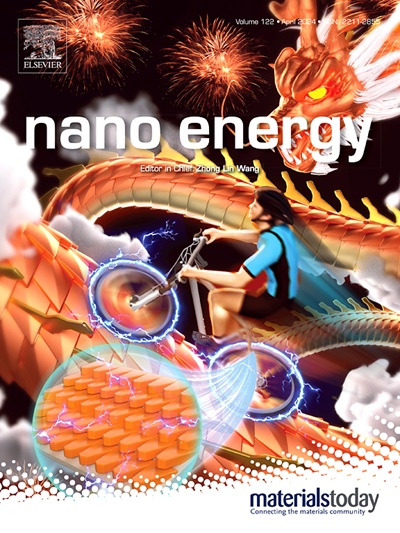Effect of ultraviolet irradiation on contact electrification at liquid-solid interface
IF 16.8
1区 材料科学
Q1 CHEMISTRY, PHYSICAL
引用次数: 0
Abstract
Liquid-solid triboelectric nanogenerator (L-S TENG) has demonstrated great potential in harvesting tiny mechanical energy from liquid. The saturated charge density of contact electrification (CE) at the liquid-solid interface is a key parameter to evaluate its performance. This study confirms that ultraviolet (UV) irradiation can enhance the saturated charge density of L-S CE, and the enhancement effect depends on the UV wavelength and intensity. The UV wavelengths that can further increase the saturated charge density of droplet -PTFE and droplet -FEP TENG are within 310–405 nm and 275–405 nm, respectively. In these wavelength ranges, high light intensity of UV irradiation favors L-S CE. The saturated charge density of FEP is up to −524 μC/m2 under optimal irradiation conditions. A series of experiments are further conducted to explore the possible influences of UV irradiation on chemical change of solid surface, ionization of water, and so on. It is proposed that UV irradiation can excite electrons in water molecules to high-energy states and make them transfer to and be trapped by solid surface. Meanwhile, the electrons on the solid surface itself, as well as those that have been transferred to the solid surface, also can be excited under specific UV wavelength irradiation, resulting in charge dissipation at the L-S interface. Finally, the photo-excitation electron transfer theory is extended to quantitatively explain the influence mechanism of UV irradiation on L-S CE. This study not only contributes to further understanding of L-S CE, but also provide an effective technique to improve the performance of L-S TENG.

紫外线照射对液固界面接触电化的影响
液-固摩擦电纳米发电机(L-S TENG)在从液体中获取微小机械能方面显示出巨大的潜力。液固界面接触通电饱和电荷密度是评价其性能的关键参数。本研究证实了紫外照射可以增强L-S CE的饱和电荷密度,增强效果与紫外波长和强度有关。能进一步提高ptfe和fep TENG饱和电荷密度的紫外波长分别在310 ~ 405 nm和275 ~ 405 nm。在这些波长范围内,高光强的紫外线照射有利于L-S CE。在最佳辐照条件下,FEP的饱和电荷密度可达-524 μC/m2。进一步进行了一系列实验,探讨紫外线照射对固体表面化学变化、水电离等可能产生的影响。提出紫外辐射可以将水分子中的电子激发到高能态,使其转移到固体表面并被固体表面捕获。同时,固体表面上的电子以及已经转移到固体表面的电子在特定紫外波长照射下也会被激发,导致L-S界面处的电荷耗散。最后,扩展光激发电子转移理论,定量解释了紫外辐照对L-S CE的影响机理。本研究不仅有助于进一步了解L-S CE,而且为提高L-S TENG的性能提供了有效的技术手段。
本文章由计算机程序翻译,如有差异,请以英文原文为准。
求助全文
约1分钟内获得全文
求助全文
来源期刊

Nano Energy
CHEMISTRY, PHYSICAL-NANOSCIENCE & NANOTECHNOLOGY
CiteScore
30.30
自引率
7.40%
发文量
1207
审稿时长
23 days
期刊介绍:
Nano Energy is a multidisciplinary, rapid-publication forum of original peer-reviewed contributions on the science and engineering of nanomaterials and nanodevices used in all forms of energy harvesting, conversion, storage, utilization and policy. Through its mixture of articles, reviews, communications, research news, and information on key developments, Nano Energy provides a comprehensive coverage of this exciting and dynamic field which joins nanoscience and nanotechnology with energy science. The journal is relevant to all those who are interested in nanomaterials solutions to the energy problem.
Nano Energy publishes original experimental and theoretical research on all aspects of energy-related research which utilizes nanomaterials and nanotechnology. Manuscripts of four types are considered: review articles which inform readers of the latest research and advances in energy science; rapid communications which feature exciting research breakthroughs in the field; full-length articles which report comprehensive research developments; and news and opinions which comment on topical issues or express views on the developments in related fields.
 求助内容:
求助内容: 应助结果提醒方式:
应助结果提醒方式:


